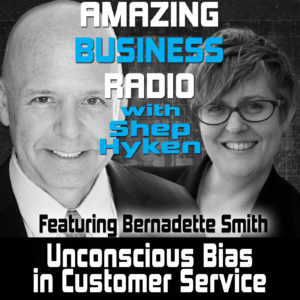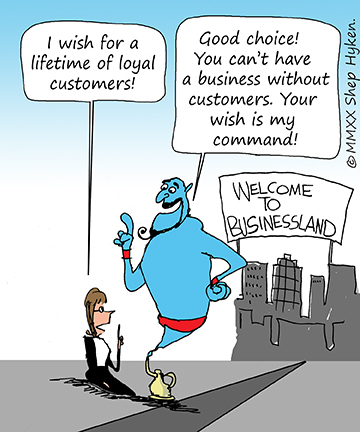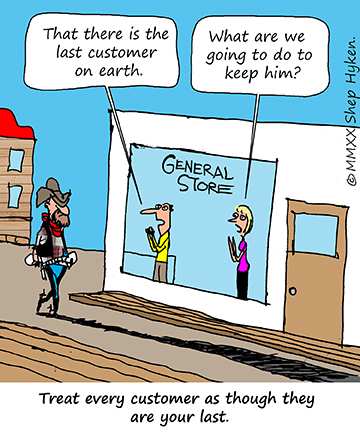Shep Hyken's Blog, page 111
February 11, 2020
Amazing Business Radio: Bernadette Smith

Unconscious Bias in Customer Service
Avoiding Assumptions So You Don’t Accidentally Offend Your Customers
Shep Hyken interviews Bernadette Smith. They discuss how inclusion and diversity training can create a better customer experience.








Top Takeaways:
Unconscious bias affects the way we think about others without being fully aware of it. It causes people to make assumptions about others that may or may not be true.
Frontline employees must be trained to be aware of their unconscious biases. When employees act on incorrect assumptions, it can potentially offend customers.
In today’s digital world, anything and everything can be filmed, put on the internet and go viral. This can turn into a PR nightmare for any company.
There is a difference between proactive training and reactive Proactive training takes place up front in an effort to prevent negative situations from arising. Reactive training occurs after there is a problem.
If an incident occurs, companies absolutely need to respond with reactive training. However, too few companies take advantage of proactive training for frontline employees.
Mistakes will happen; this is inevitable. It’s how a company handles the aftermath that is really important.
The best thing to do to avoid accidentally offending customers is to ask them questions. Ask questions from a position of curiosity, rather than confrontation, to better understand the situation and avoid making incorrect assumptions.
Our brains process information and make connections very quickly, whether or not those connections make sense. Pause, take a breath, and think for a moment before judging a situation and reacting.
Becoming aware of unconscious bias and avoiding assumptions is not difficult, nor does it take too much time. Anyone and everyone can do it.
Diversity and inclusion training can and should be incorporated into a company’s culture, core values and existing training. View it as another way to provide excellent customer service.
Quotes:
“To help avoid the mistake of acting with unconscious bias, ask better questions and lead with curiosity instead of confrontation.”
“Take a breath and stop to think before you make an assumption. It really is that simple.”
“You can’t provide excellent customer service when you are making incorrect assumptions about your customers.”
About:
Bernadette Smith is the founder, president and CEO of Equality Institute. She is also an award-winning author of three books and will release her fourth book in 2020.
Shep Hyken is a customer service and experience expert, New York Times bestselling author, award-winning keynote speaker, and your host of Amazing Business Radio.
The post Amazing Business Radio: Bernadette Smith appeared first on Shep Hyken.
February 10, 2020
5 Top Customer Service Articles For the Week of February 10, 2020
Each week I read a number of customer service and customer experience articles from various resources. Here are my top five picks from last week. I have added my comment about each article and would like to hear what you think too.
How the Digital Era Is Redefining Customer Experience by John Finch
(No Jitter) As customers become more reliant on non-voice methods of communication, CCaaS serves as a necessary aggregation platform.
My Comment: We’re in a digital age. Our customers are expecting, if not demanding, that the companies they do business with have alternatives (emphasizing the plural) to the traditional phone support. Where did the digital era start? Back in the 1960s. The author gives us a little history and some current insights into what we need to do in the digital age of customer service.
10 Marketing Lessons from Apple [Infographic] by The Website Group
(The Website Group) Read on for a list of 10 marketing techniques that Apple has used to build one of the most well-known brands in the world!
My Comment: Customer experience and marketing are very much connected. This short article and infographic has ten marketing tips that cross over to the CX world. Number one is keeping it simple. Number six is about creating experiences, not just products. Couldn’t get any closer to CX than that!
Bigfoot Customer Service. What Is It and Why Are You Still Giving It? by By Steve DiGioia
(Steve DiGioia) Bigfoot. The elusive missing link between humans and apes. But what does he have to do with customer service? Well, plenty. There are many similarities between the creature and the service many of us dish-out to our customers. That’s why I call it, Bigfoot customer service. Let’s get into it.
My Comment: We all know what Bigfoot is; something between a human and an ape. Some claim they have seen Bigfoot, but much of that is a rumor. So, maybe Bigfoot is real, or maybe he/she/it is not. Customer service expert Steve Digioia has written a short and humorous article about how some companies deliver Bigfoot style customer service. I love the metaphor.
How B2B Companies Can Up Their Customer Experience Game Based on Insights from Nicholas Caffentzis
(KelloggInsight) Most companies focus on their own sales targets. They should be focusing on their clients’.
My Comment: I’ve talked to executives from B2B companies who feel that customer experience is not as important to them as it is for consumer-focused B2C companies. That can’t be further from the truth. It’s just as important and maybe even more so, as many B2B’s have few clients than typical B2C’s. Here are some great insights – and even though they are focused on B2B – have relevance to all types of companies.
5 ways to increase customer retention in 2020 by Michael Barnard
(CustomerThink) We have outlined 5 simple steps for you to increase your customer retention in 2020 and ultimately grow your revenue today and into the future.
My Comment: How do you increase customer retention? Determine who your best customers are and then find more just like them. While that’s an over-simplification of one of the points, it’s a good one. And, while the focus is on retention, giving the customer the right experience will not only retain them but could make them loyal.
BONUS
Top 10 Customer Satisfaction Quotes By Leading Industry Experts! by Lipi Khandelwal
(MarTech Advisor) In this article, we explore customer satisfaction and its importance through selected quotes from leading industry experts.
My Comment: Our friends at Martech Advisor assembled ten quotes from some very notable customer experience experts. (I’m honored to be included.) I think you’ll find more than one of them to be inspiring – and a possible topic to discuss at your next team meeting.
 Shep Hyken is a customer service expert, professional speaker and New York Times bestselling business author. For information on The Customer Focus
Shep Hyken is a customer service expert, professional speaker and New York Times bestselling business author. For information on The Customer Focus customer service training programs go to www.TheCustomerFocus.com. Follow on Twitter: @Hyken
customer service training programs go to www.TheCustomerFocus.com. Follow on Twitter: @Hyken
The post 5 Top Customer Service Articles For the Week of February 10, 2020 appeared first on Shep Hyken.
February 7, 2020
Guest Post: Why Businesses Must Emphasize a Human Touch Over the Phone
This week we feature an article by Riley Panko, a Senior Content Developer & Marketer at Clutch. She emphasizes the need for human interaction over the phone in a world of automated response systems.
In the age of chatbots, contact forms, and phone menus, consumers still seek human interaction when communicating with a business and will grow frustrated if that interaction is delayed or not allowed. New data on phone menus found that businesses should only use phone menus when absolutely necessary, keep the menus short, and always allow the option to speak to a human. Use this article to create a stronger customer service function and develop a phone-based communication system that emphasizes human connection.
Phone Menus Are Not Always Necessary
A phone menu seems like an ideal solution for businesses looking to reduce the human labor needed for customer communication. In fact, over 70% of people say they encountered a phone menu always or frequently when calling businesses. Yet, businesses should carefully consider whether a phone menu is actually necessary before implementing one. Phone menus work best for businesses with multiple departments, where the menu can potentially connect the customer with the right expertise more efficiently than a human operator. For smaller businesses, though, employees may be able to answer all questions received over the phone. In this case, having a phone menu may be unnecessary, even if it requires employees to spend a little bit more time over the phone. Overall, a phone menu should be used if it will benefit the customer, not just the business’ bottom line.
Keep Phone Menus Short
Businesses may not realize just how short a well-designed phone menu should be. Many businesses may be tempted to develop as many options as they can think for their phone menu, thinking more options will mean more answers for customers. Instead, this approach will just frustrate customers who need to listen to a long menu to find the one answer they want. Businesses can consider other means of shortening the time a customer spends listening to a phone menu. These options can include:
AI-powered Automated Speech Recognition (ASR) systems that allow customers to speak their question and be routed to an answer or representative based on keywords or phrases.
Pre-routing, or routing a customer’s call to a different option before they pick up based on if the number is from a new or existing customer.
By offering alternative options to customers outside of a phone menu, your business can create a more enjoyable experience for customers and route them to their desired point of contact quickly.
Always Allow the Option to Speak to a Human
In the end, a phone menu should always easily offer the option to speak to a human. Most people end up speaking to a human by the end of a call with a business anyways; 72% of people always or frequently speak to a human after encountering a phone menu, according to the Clutch survey. When people’s desire to speak to a human is impeded, they’ll attempt a number of actions, including:
Pressing zero
Saying words such as “operator”
Cursing
Businesses struggling to keep up with their phone-based communication may need more than a phone menu to adequately meet customer service demands. If they don’t have the in-house resources to answer the phones, an outside answering service can potentially assist.
Providing an Intuitive Experience With Your Business’ Phone System Should Include a Human Element
Phone menus can provide an efficient and intuitive path for your customers to resolve an issue or find more information about your company. First, make sure a phone menu is necessary for your company. If your employees have the knowledge to address most, if not all, customer inquiries, it may be better to rely on them to do so. To make sure that customer experiences with your business are informative and user-friendly, you should consider creating a phone menu that presents limited options. Consider complementing your answering service with voice services technology that can direct customers based on issues they specify. Finally, always make sure to include the option to speak to a human representative. Some issues cannot be resolved without human judgment, and some customers only feel comfortable speaking to other people about an issue.

Riley Panko is a Senior Content Developer & Marketer at Clutch, a B2B research firm in Washington, DC. Recently, she has published original content on the voice services, human resources, and accounting industries.
F
 or more articles from Shep Hyken and his guest contributors go to customerserviceblog.com.
or more articles from Shep Hyken and his guest contributors go to customerserviceblog.com.
Read Shep’s latest Forbes article: Fraud Is Eroding The Customer Experience
The post Guest Post: Why Businesses Must Emphasize a Human Touch Over the Phone appeared first on Shep Hyken.
February 5, 2020
The Last Customer on Earth
What if you only had one customer left to do business with? Maybe this was the last customer on earth?
Norman Beck—my friend and faithful reader of The Shepard Letter—and I were talking about this idea and he shared another way of looking at it. In his words, “It’s like the last gas station you’ll see for miles as you enter the desert. Maybe you stop and make sure you have a full tank of gas.” Of course, you don’t want to run out of gas in the middle of the desert! In business terms, maybe you’ll focus on making sure this customer is happy, filling the metaphorical gas tank with an excellent customer experience, so you can last—or stay in business—until you get another customer.
Let’s pretend for a moment. What if this were true? Not so much that your customer is the last on earth, but that they are the only one you have. Maybe this is your first—and only—customer. Or maybe, due to a tough economy, customers aren’t buying or spending like they used to, meaning all but one have stopped doing business with you. Regardless, you just have one customer and you want to keep them. How? Ask yourself the following questions:
What do you currently do to add value for your customers? This is not a brainstorm of what you could do. This is what you’re already doing. Think about what you do that makes customers want to do business with you instead of your competition. Think about any compliments you’ve received from them in the past.
What are you doing that might cause your customers to leave? Imagine that you’re losing customers—this may not be true, but imagine it is. Consider any and all complaints you’ve heard about. This is a good place to start.
What do you do that is different from your competition? I’ve posed this question before. This is about differentiation—what you do that is unique or special compared to others. It could be something as simple as hours of operation. Do you offer a product that others don’t? Is your process different? Whatever you come up with, it must be something a competitor couldn’t say. For example, don’t say, “We have great service.” The competitor might believe they have great service, too. It must actually be different and make you stand out.
The over-arching question you should ask yourself is, “What would you do to keep your last customer?” Get a team together and brainstorm answers to these questions and others you may come up with. Once you have the answers, you may never have to worry about only having one customer—your last customer.
Shep Hyken is a customer service expert, keynote speaker, and New York Times bestselling business author. For information, contact 314-692-2200 or www.hyken.com. For information on The Customer Focus customer service training programs, go to www.thecustomerfocus.com. Follow on Twitter: @Hyken
customer service training programs, go to www.thecustomerfocus.com. Follow on Twitter: @Hyken
(Copyright © MMXX, Shep Hyken)
The post The Last Customer on Earth appeared first on Shep Hyken.
February 4, 2020
Amazing Business Radio: Stacy Sherman

The Voice of the Customer
Creating WOW Moments by Simply Being Human
Shep Hyken interviews Stacy Sherman. They discuss strategies for improving CX throughout every level of an organization.








Top Takeaways:
It’s important to consider and optimize CX across the board, but especially within three key areas: digital channels and e-commerce, sales and the frontline, and especially new product development.
Very few companies take the customer experience into consideration when designing new products. Incorporate the customer’s voice throughout that process and give them a seat at the table from the very beginning.
Poll the customers and personas to whom you’re marketing and find out their wants and needs. Create your product using that information.
Customer service is a key component of the customer experience. Ensure every employee understands their role within the larger customer experience, even if they never interact directly with the customer.
Celebrate your customers and the employees who create excellent experiences. Make it a part of your culture. If you choose to celebrate and devote a day or a week to CX (similar to National Customer Service or CX Week), don’t forget that it’s still a year-round effort.
Positive change within customer experience and company culture must start from the top. Executives must be fully on board for it to become a part of the culture. They must be role models and champions of the CX initiative.
Quotes:
“Infuse the customer voice within the development of new products. Make sure the customer is at the table right from the beginning.”
“Companies and leaders should think about what they can do to delight customers that has nothing to do with the price tag.”
“Business to business or business to consumer, at the end of the day, it’s human to human. People buy from people.”
About:
Stacy Sherman is the Director of Customer Experience & Employee Engagement at Schindler Elevator Corporation. She designs and implements successful customer-centric programs and other projects for well-known brands. (Please note that all views expressed are Stacy’s and do not reflect the opinions of or imply the endorsement of employers or other organizations.)
Shep Hyken is a customer service and experience expert, New York Times bestselling author, award-winning keynote speaker, and your host of Amazing Business Radio.
The post Amazing Business Radio: Stacy Sherman appeared first on Shep Hyken.
February 3, 2020
5 Top Customer Service Articles For the Week of February 3, 2020
Each week I read a number of customer service and customer experience articles from various resources. Here are my top five picks from last week. I have added my comment about each article and would like to hear what you think too.
6 Hot Customer Loyalty Trends Emerging in 2020 by Brad Davis
(Digital Doughnut) As someone whose job it is to keep a watchful eye on what’s happening in customer loyalty, I’ve compiled this list of essential trends to keep in mind this year. Ignore these trends, and you risk losing your customers to competitors that are staying on top of where the industry is going!
My Comment: Here’s a short article about six trends we should all be aware of and, if appropriate, consider for our organization. Ideas on customers’ desire for “instant gratification,” personalization, social responsibility and more are covered. Loyal customers buy more often, spend more and will even talk about you to their colleagues and friends. Who doesn’t want customer loyalty?
Leveraging Tech To Improve Customer Experience: 11 Smart Techniques by Expert Panel
(Forbes) 11 members of Forbes Technology Council explain some techniques businesses can use to improve their customers’ experience.
My Comment: Technology continues to play an ever-increasing important role in the customer experience. It is more important than ever to have positive interactions with your customers that go beyond human-to-human. Managing the digital experience is crucial. 11 members of the Forbes Technology Council share their ideas on how businesses can leverage technology for a better customer experience.
Exploring the Full Potential of Customer Experience by Mary Drumond
(Worthix) I’d like to make the case that most companies out there are still failing to explore the full potential of Customer Experience. While the general concept of CX may have hit mainstream, converting that concept into actionable results still seems to be a ways out.
My Comment: What’s your definition of customer experience? Years ago it was just another phrase for customer service. It’s changed since then. A lot! This author has her take on what it means, and it’s worth considering. She shares a few other definitions from Gartner, Forrester and more. Great “food for thought.”
Add Enchantment To Your Customers’ Experiences by Chip Bell
(Forbes) The Craddock Terry Hotel is a case study in customer experience whimsy.
My Comment: Here’s an interesting concept in customer experience: enchantment. Customer service expert Chip Bell defines enchantment as, “The outcome when children’s stories and children’s imaginations partner to entertain, intrigue, instruct, and inspire,” and then goes on to explain the role it plays in the customer experience.
5 Reasons to Invest Now in Customer Experience by Andrew Neff
(ICMI) Here are five reasons why the time is now to advocate for efforts to enhance CX.
My Comment: How do you get leadership to invest in customer experience? This article has five compelling reasons to do so. So, the next time you approach leadership about making an investment in this oh-so-important area, consider working one or more of these reasons into your pitch deck and story.
BONUS
Do You Know What Your Customers Really Want? [Infographic] by Jennifer Hanford
(Business2Community) Let’s talk about a few things to consider for gaining more insight into your customers’ “wish lists.” As a bonus, following the tips that I share will also help your business stand out from other companies within your industry.
My Comment: Here’s a bonus… A short article and infographic about what customers really want. The article starts off with three tips and then includes a visual graphic with stats and facts tied to the customer support center.
 Shep Hyken is a customer service expert, professional speaker and New York Times bestselling business author. For information on The Customer Focus
Shep Hyken is a customer service expert, professional speaker and New York Times bestselling business author. For information on The Customer Focus customer service training programs go to www.TheCustomerFocus.com. Follow on Twitter: @Hyken
customer service training programs go to www.TheCustomerFocus.com. Follow on Twitter: @Hyken
The post 5 Top Customer Service Articles For the Week of February 3, 2020 appeared first on Shep Hyken.
January 31, 2020
Guest Post: How Good Customer Service is Defined by 4 Different Generations
This week we feature an article by Pem Brooke, Marketing Manager of SuperStaff. Pem discusses the importance of shifting customer service tactics in order to cater towards customers from each generation.
Not many companies think about generational gaps and differences when it comes to dealing with their clients.
Some brands think that dealing with customers with uniform responses and procedures increases their efficiency and effectivity—when, in fact, some customers may feel alienated if the support agents of a company do not match their communication styles with the expectations of the age group they are dealing with.
Businesses must keep their eyes on the sky and their ears to the ground when it comes to this world’s rapidly changing trends, themes, and pulse, but must never neglect the lifestyles, attitudes, technological aptitude, and the overall customer service expectations of their clients according to generational differences.
According to research conducted by New Voice Media, US-based businesses lose up to $62 billion yearly from having bad customer service. Score says that 91% of your clients will leave your company for an alternative brand if they experience bad customer service.
There is definitely no one-size-fits-all strategy when it comes to dealing with clients, but having a heightened level of awareness on their needs will give you a degree of mastery when it comes to enhancing your brand’s customer support efficiency, increasing client service ratings and raising customer retention by a great deal.
The Four Generations of Clients
It really depends on the industry and scope of work your business does, but most companies deal with clients from four major generational groups: Matures, Baby Boomers, Generation or Gen X, and Millennials.
Marketing and communications expert Kelly McDonald provided some guidelines in her book, Crafting the Customer Experience for People Not Like You, so that readers could gain a better general understanding of each generation.
Matures- born before 1945
Baby Boomers- born between 1946 and 1964
Gen X- born between 1965 and 1981
Millennials (also called Gen Y)- born in between 1982 and 2004
Gen Z- born from 2005 to present
Our focus in this article will remain with the first four on the list, as Gen Z’s are still making their way into the world and therefore do not have as much spending power compared to the older sets.
Matures
Often described as “traditionalists,” this consumer age group combines two generations—the “Greatest Generation,” also known as the GI generation, born in 1924 or earlier, and the “Silent Generation,” composed of individuals born in 1925–1945. Matures have seen some of the darkest times in history, including the Great Depression and World War II.
Matures by now are mostly in their retirement years. A lot of them find adapting to technology and complicated instructions to be quite tedious. Some may have a degree of online and computer know-how, but it can still be a challenge for them to deal with procedures that require advanced technical knowledge. They are used to traditional forms of communication like handwritten letters and phones.
The key to dealing with the Matures is to up your personalization when providing customer support. Treat them with patience and special treatment. Teaching your agents to utilize tools for remote assistance, as well as screen-sharing features whenever possible, will speed up processes and help this generation gain better understanding of how your products or services work.
Baby Boomers
Boomers are the first generation to grow up with television sets in their living rooms. This has given them the inherent interest and ability to keep up with global trends and phenomena.
According to a study, boomers put a premium on price points above all other things when considering a product or service. They like using emails, have appreciation for vis-à-vis meetings, text messaging, and the telephone.
Known as big spenders (since they have the highest disposable income among the generations), they value brand loyalty but also reported to be more willing to try out new products. In fact over 85% of boomers are comfortable doing online browsing and shopping.
Your brand could succeed in marketing to this generation through social media and SMS. Baby boomers are not likely to download and utilize digital applications for transactions. They still prefer brick-and-mortar stores, with 67% of those surveyed reporting that they still prefer buying at their local retailer even if the item is available online.
Generation X
The middle generation, often labeled as the bridge between baby boomers and the millennials, Gen X individuals are now mostly in their 40s. At this point, a lot of them are at the height of their earning capacity and are very busy with juggling a variety of tasks on their plate—managing home ownership, businesses, child-rearing, and much more.
This generation is mostly computer literate, with more than 80% of them reportedly using social media platforms like Facebook and Twitter. Gen Xers value independence, as well as individual choice. They prefer high-tech communication methods, optimized systems for smooth processing, and give credence to being fully informed before diving into the nitty-gritty of things.
Having a wide selection of support channels will be useful when marketing to them, including email marketing, social media targeting, and many more.
Millennials
These adults have grown up with computers and the internet. They use both tools extensively in their everyday lives for a wide variety of tasks—including self-learning, entertainment, and making connections with the people and communities they value in life.
As consumers, millennials are an omnivorous breed of customers who are most likely to utilize each point-of-sale avenue available. Millennials in the younger set (20–23 years old) are proven to be more likely to purchase in physical stores compared to their older millennial counterparts aged between 32 to 35, who will most likely shop through mobile apps or online stores.
Synchrony reports that 82% of millennials say that word-of-mouth is a primary motivator when it comes to their purchase decisions. As a brand, you can gain millennials’ trust and loyalty by showcasing good reviews on your products or services whenever possible, encouraging these digital natives to follow you on socials, and giving them real-time customer support that addresses their needs efficiently.
Conclusion
Providing the best customer experience is possible if you have a good grasp of your client’s lifestyles, needs, wants, and generational communication preferences.
Having proactive solutions in place, such as flexible working hours, for your customer support team is also advantageous, especially for bigger businesses, since clients from different generations have varied timetables when it comes to upsurges in their activity level and idle times.
Use different channels to communicate with them, and run tests to see which customer service solutions fit for your brand and your customers’ needs. Adjusting your communications strategies accordingly will boost your efficiency, and in turn, your company’s bottom line.
Pem Brooke is the Marketing Manager of SuperStaff. Prior to working at Logiscale, he handled a small marketing agency in Los Angeles. In his free time, he pampers his dog all day long.
F
 or more articles from Shep Hyken and his guest contributors go to customerserviceblog.com.
or more articles from Shep Hyken and his guest contributors go to customerserviceblog.com.
Read Shep’s latest Forbes article: Transform The Customer Experience
The post Guest Post: How Good Customer Service is Defined by 4 Different Generations appeared first on Shep Hyken.
January 29, 2020
Once Upon A Time In Businessland
 Today I share with you a fable.
Today I share with you a fable.
Once upon a time a great genie paid a short visit to the town of Businessland, where he happened upon three entrepreneurs, each of whom wanted to open an ice cream shop. The great genie offered to grant each of them a wish, but only if that wish would absolutely guarantee the success of their venture. The first entrepreneur said, “I wish for the best tasting ice cream in all of Businessland.” The genie frowned and said, “I will not grant your wish. The best ice cream on earth won’t guarantee your success.” The second entrepreneur said, “I wish for the best location in Businessland.” Again, the great genie frowned and said, “No, I will not grant that wish either. Even the best location doesn’t guarantee your success.” The third entrepreneur thought for a moment, and then she said, “I wish that every day I will have a long line of customers who can’t wait to buy my ice cream.” The great genie smiled and said, “Your wish is my command!” With that, the third entrepreneur reaped the success of a never-ending line of loyal customers.
Here’s the point. Without customers, it doesn’t matter how good your ice cream or location is. While those are helpful, what really matters is that you have customers.
You can’t have a successful business without customers. Once you have them, don’t blow it. While you probably don’t have a real genie to bring you customers (although I don’t want to completely rule out the possibility), you probably do have people managing your marketing and sales efforts. Those people will bring you customers. But their efforts are worthless if, once the customer finally decides to do business with you, they are disappointed with their experience. Disappointment can come from any number of places—a process that’s marred with friction or a bad experience with an employee.
That’s where I come in. Almost everything I’ve written about and shared via video since I’ve been in business for more than 38 years has been about customers—specifically, getting customers to love doing business with you, come back time after time and become an extension of your sales and marketing efforts by evangelizing your products and services. Why? Because of an amazing customer experience!
If you’ve made it this far, it’s obvious customers are important to you. How can you create an amazing experience for them? I suggest you read some of my past articles or watch my videos. The story about the genie comes from the first chapter of the updated and revised edition of my book, The Cult of the Customer. If you liked it, you can preorder the book through my website, which will get you immediate access to the eBook free of charge, along with another special gift. So you see, you have many resources at your disposal to help you create an amazing customer experience. Best of all, you don’t have to wait to be in the cult you really want to belong to… The Cult of the Customer!
Shep Hyken is a customer service expert, keynote speaker, and New York Times bestselling business author. For information, contact 314-692-2200 or www.hyken.com. For information on The Customer Focus customer service training programs, go to www.thecustomerfocus.com. Follow on Twitter: @Hyken
customer service training programs, go to www.thecustomerfocus.com. Follow on Twitter: @Hyken
(Copyright © MMXX, Shep Hyken)
The post Once Upon A Time In Businessland appeared first on Shep Hyken.
January 28, 2020
Amazing Business Radio: Bob Chapman

Employees Matter
Care for Your Employees and They Will Care for Their Customers
Shep Hyken interviews Bob Chapman. They discuss his leadership philosophies and approach to creating a “truly human” culture of caring.








Top Takeaways:
You don’t need to have an out-of-the-ordinary or “exceptional” background to do exceptional things in business and your life.
Business has the potential to be the most powerful force for good in the world. It begins with companies truly caring about their people.
The most important thing for any business is to develop a sustainable business model in which people feel valued.
Many businesses make the mistake of only caring about numbers. Leaders instead should care about their people, making them the number one priority.
Create a work environment where people feel safe and valued. Give them hope for the future. That will make them feel engaged and give them the desire to contribute.
A leader’s job should be to help the people they have the privilege of leading grow and develop in line with the company’s vision.
Customers ultimately benefit from the good treatment of employees. If you take care of your employees, they will take care of their customers.
Find ways to make work fun. Fun is an excellent motivator that increases employee engagement and productivity.
The way employees are treated at work affects their behavior outside of work. Therefore, it is a leader’s responsibility to take the best care of the people within their stewardship. This has the potential to make the entire world a better place.
For more from Bob Chapman, check out his appearance on Shep’s TV show, Be Amazing or Go Home .
Quotes:
“Our fundamental responsibility as leaders is to give people a circle of safety.”
“Management is the manipulation of others for the company’s success. Leadership looks at the people they have the privilege of leading and defines success as the development and growth of those people.”
“There is no doubt that employees who feel cared for take better care of their customers.”
“The way we lead our organizations impacts the way the people of our organizations lead their lives at home.”
“Business could be the most powerful force for good in the world if we simply cared about the people we have the privilege of leading.”
About:
Bob Chapman is the Chairman and CEO of Barry-Wehmiller. He developed management practices known as “Truly Human Leadership” and co-wrote Everybody Matters: The Extraordinary Power of Caring for Your People Like Family.
Shep Hyken is a customer service and experience expert, New York Times bestselling author, award-winning keynote speaker, and your host of Amazing Business Radio.
The post Amazing Business Radio: Bob Chapman appeared first on Shep Hyken.
January 27, 2020
5 Top Customer Service Articles For the Week of January 27, 2020
Each week I read a number of customer service and customer experience articles from various resources. Here are my top five picks from last week. I have added my comment about each article and would like to hear what you think too.
Leveraging Trends to Drive Business Success through Customer Experience by Joseph Michelli
(The Michelli Experience) I see my job as curating much of that research and sharing it with you in this context and also helping my clients leverage that knowledge through tools and technologies. In keeping with that objective, let’s look at some data reported by Adobe and Econsultancy in a report titled Experience Index 2020 Digital Trends.
My Comment: Joseph Michelli has written an excellent article about how to leverage trends in the customer experience world. Consider this: “Today’s consumers expect easy, valuable experiences that marketers in 2010 could scarcely imagine.” Joseph shares some recent stats and facts along with his insightful comments.
Biometrics – A new normal for customer experience by Sarah Amundsson
(CustomerThink) Biometrics are transforming the way we interact and engage with our customers. From mobile devices that require biometric authentication to replacing the pin codes and using biometric data to open accounts, the business world is undergoing a transformation.
My Comment: The other day I boarded a flight. The airline didn’t need to see my boarding pass. There was a camera that took my picture and immediately confirmed it was me and what seat I was assigned. While not new, this is a technology that is starting to trend as “business as usual.” This article will introduce you to biometrics and how it’s impacting the customer experience.
What Is Job satisfaction? Definition, Factors, Importance, Statistics, and Examples by Chiradeep BasuMallick
(HR Technologist) Job satisfaction is defined as the level of contentment employees feel with their job. This goes beyond their daily duties to cover satisfaction with team members/managers, satisfaction with organizational policies, and the impact of their job on employees’ personal lives.
My Comment: This is a very robust article focused on employee satisfaction. Plenty of ideas on how to create employee satisfaction, employee engagement and the positive impact it has on the company and its customers.
Customer Retention Strategies To Explode Your Business In 2020 by Matt Duczeminski
(Insane Growth) Customers are the fuel that keep your business running and effective customer retention strategies will keep them buying from you over and over again.
My Comment: How can I not love an article about customer retention – especially with it’s from www.InsaneGrowth.com. Here are plenty of strategies that will help you grow your business through customer retention. Don’t just attract new customers. Get them to come back – again and again!
Spending on customer experience increases as its impact is more widely recognized by Barry Levine
(ClickZ) Customer experience (CX) efforts remain inconsistent in many organizations, but there are signs of greater commitment and execution for 2020, according to Gartner.
My Comment: 74% of companies expect to spend more money on customer experience in 2020. About a third of them will spend significantly more. Why? Because the ROI on creating a good customer experience is a good investment. It doesn’t cost. It pays.
BONUSES
The Ultimate Customer Experience Primer by Nate Brown
(CX Accelerator) This guide will serve as a comprehensive starting point for Customer Experience Management.
My Comment: Want to “accelerate” your customer experience initiative? Then read this very comprehensive article – should I say “primer” on exactly how to do just that.
10 Popular Customer Experience Keynote Speakers in the World by Steven Van Belleghem
(Steven Van Belleghem) I want to present you 10 of the most renowned and experienced keynote speakers on the topics of customer experience and marketing.
My Comment: I’ve included this article as I’m very honored to be on this list of the top ten customer experience speakers in the world. Thanks to Steven Van Belleghem for including me.
 Shep Hyken is a customer service expert, professional speaker and New York Times bestselling business author. For information on The Customer Focus
Shep Hyken is a customer service expert, professional speaker and New York Times bestselling business author. For information on The Customer Focus customer service training programs go to www.TheCustomerFocus.com. Follow on Twitter: @Hyken
customer service training programs go to www.TheCustomerFocus.com. Follow on Twitter: @Hyken
The post 5 Top Customer Service Articles For the Week of January 27, 2020 appeared first on Shep Hyken.




